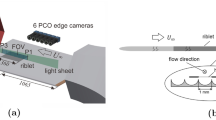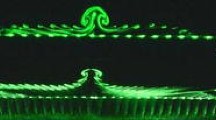Abstract
The boundary layer over a drag reducing riblet surface is investigated using hot-wire anemometry and flow visualisation. The concept of a ‘riblet sublayer’ is introduced, and a definition is proposed in terms of a region of reduced turbulence energy production formed near the wall by the addition of riblets. The hot wire records are examined using a modified form of quadrant analysis, and results obtained over plain and riblet surfaces are compared. Close to the wall, the addition of riblets produces a marked reduction in the occurrence of ‘ejection’ (2nd quadrant) events. A corresponding increase in the incidence of ‘sweep’ (4th quadrant) events is accompanied by the development of a strong tendency toward a preferred event duration, and a preferred interval between events. These changes diminish rapidly with distance from the surface, becoming almost undetectable beyondy +=40. They are discussed in the light of flow visualisation results, and interpreted in terms of mechanisms associated with the interaction between the riblets and the inner boundary layer flow structures. A conceptual model of the flow mechanisms in the riblet sublayer is proposed.
Similar content being viewed by others
References
Bacher, E.V. and Smith, C.R., A combined visualisation-anemometer study of the turbulent drag reducing mechanisms of triangular micro-groove surface modification.AIAA Paper 85-0548 (1985).
Bogard, D.G. and Tiederman, W.G., Burst detection with single-point velocity measurements.J. Fluid Mech. 162 (1986) 389.
Choi, K.-S., Near-wall structure of a turbulent boundary layer with riblets.J. Fluid Mech. 208 (1989) 417.
Clark, D.G., Boundary layer flow visualisation patterns on a riblet surface. In: Coustols, E. (ed.),Turbulence Control by Passive Means. Dordrecht: Kluwer Academic Publishers (1990).
Gallagher, J.A. and Thomas, A.S.W., Turbulent boundary layer characteristics over streamwise grooves.AIAA Paper 84-2185 (1984).
Perry, A.E., Henbest, S. and Chong, M.S., A theoretical and experimental study of wall turbulence.J. Fluid Mech. 165 (1986) 163.
Tang, Y.P. and Clark, D.G., On turbulence generating events in turbulent boundary layer.QMW-EP-1086 (1991).
Wallace, J.M., On the structure of bounded turbulent shear flows. In:Proc. NASA Boundary Layer Structure Workshop. [Langley Research Center, Hampton, Virginia, August 28–30, 1990.]
Walsh, M.J., Riblets. In: Bushnell, D.M. and Hefner, J.N. (eds),Viscous Drag Reduction in Boundary Layers. Progress in Astronautics and Aeronautics 123. (1990) p. 203.
Author information
Authors and Affiliations
Rights and permissions
About this article
Cite this article
Tang, Y.P., Clark, D.G. On near-wall turbulence-generating events in a turbulent boundary layer on a riblet surface. Appl. Sci. Res. 50, 215–232 (1993). https://doi.org/10.1007/BF00850558
Issue Date:
DOI: https://doi.org/10.1007/BF00850558




